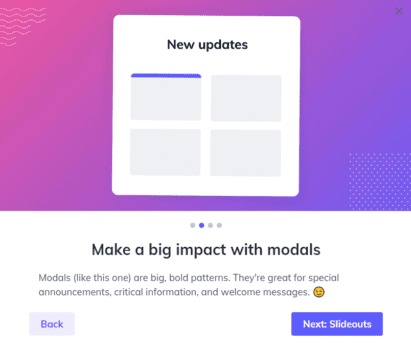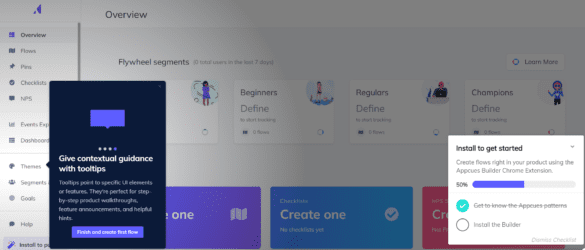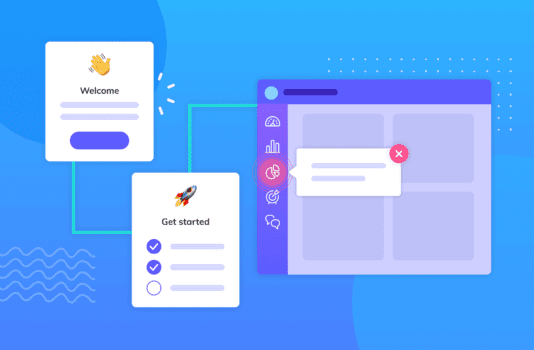You have spent a lot of time building your business application – a great product with useful features.
Now, the aim is to onboard as many users as possible.
How many users you manage to attract to your application is dependent on a number of factors – one of them is user onboarding. The first step to increase adoption is to create a great onboarding experience for your users.
This article will:
- Reveal some superb user onboarding examples
- Discuss some best practices for user onboarding
So, let’s get right in:
Superb user onboarding examples
A particularly exceptional example of user onboarding is Appcues – a company that has created a well thought-out user onboarding process.
Let’s deep-dive into the steps used in their onboarding
They begin by welcoming the users.

A slideshow follows. Users have the option to view the four slides or click on the “Next” option.
A small pop-up related to slideouts appears.

Notice how the instructions message pops-up on the left side instead of annoying the user by covering the whole screen.
Once you click on the tooltips option, a hotspot appears.
The usage of hotspots from Appcues is also very thought-out. They display the necessary installations in a subtle manner, instead of a flashy throwing it in your face manner.
The hotspot also makes it clear how to create the first flow.
After the message is displayed, users can click on the CTA and create their first flow.
Appcues covers the whole screen with the message when the user clicks on the tour option – it doesn’t cover the screen unnecessarily. This way, the user doesn’t get frustrated.
Appcues gives a tour of the option with messages that pop-up to help the user during onboarding. A pop-up message appears that gives you a piece of information that you didn’t know before so users are bound to read it.
When the user clicks on “Next”, the following pop-up appears on the left-hand side. The bottom right of the screen gives a CTA that prompts the user to “Start building”.
Appcues understands that pop-up messages divert attention from users, so they use it only where it is essential i.e where it provides actual value.
Here are some other examples of great user onboarding. Don’t miss out on how big companies such as Slack, TikTok and Grammarly do their onboarding.
Absolutely important practices for user onboarding
Let’s discuss some of the best onboarding practices for your application:
Payment plans
The customer already has an idea about the subscription charges. However, if there are any features or services that require an additional payment, it should be conveyed during the onboarding.
For instance, the user is on a basic plan, showing the charges for the pro plan features is a way to build trust.
No one likes hidden charges. Especially the customer who is just going through onboarding. Be as upfront as possible.
Hotspot
Have you ever seen small bubbles that appear when you hover your mouse over certain elements of an application? They are known as hotspots – used to provide instructional information to help guide users in the right direction.
Users learn more about your product without having to search through numerous pages and guides.

Some information does not fit appropriately inside a hotspot. In that case, if the feature is important enough an email can be sent to the user so that they know how they’ll benefit from that feature.
Make the complex steps easy
If the application is technical, the sign-up process has to be simple. The customer should not be overwhelmed by the complexity of the application before they even start using it. The aim is to focus on one key feature at a time. Cluttering the onboarding process with too many features will only confuse the user.
Keep the sign-up process short and direct to the point. Link a detailed Knowledge Base article for users who want to get the meaning of technical jargon.
Remember, you don’t want to be explaining all the topics in detail and neither do you want the user to have no idea how to operate the application.
Find the sweet spot between them.
Tutorials
Creating tutorials from scratch can be time consuming, but it helps curate useful content for your customers. Users can take advantage of video tutorials and walk-throughs for a positive experience. This will not only save you time but it also helps the customer to understand your application better.
Remember that users like to do things their way.
Don’t try dictating to the users what steps to take. They might find an easier way to do it or one that suits them.
Regular touch points
It’s important that the customers remain engaged with your application while they are onboarding. You don’t want them to forget about the application.
Send regular emails with helpful tips about your application.
If the user stopped at some part of the onboarding process, the email will serve as a reminder. It is also a great way to ensure that users know how to use the app and are still engaged.
In addition, you need dedicated customer support. Read more on how to provide amazing customer service. Users should be able to reach out to the team whenever they’re stuck.
Purchase process
Have you ever gone through a website in which purchasing has been made difficult? Navigating through complex forms and payment options can be tedious.
Having a straightforward purchase process for the user is a best practice to always keep in mind. Have an easily understandable form layout, with clear instructions on how to proceed further in the purchase.
This doesn’t mean not to provide users with important information.
Simplicity helps users stay focused on their goals and ensures that they don’t feel overwhelmed. The onboarding should be simple – similar to the purchase process.
Customer feedback
It’s essential to see how your initial customers react to your product.
Use a tool such as Hotjar to track how your initial users react to your application. What features do they click on? What’s their time spent on a particular page? What features do they find to be confusing?

Using these insights, tweak your onboarding to provide the best experience. Discover any areas that need improvement so that you don’t lose customers in the long run.
After onboarding, reach out to the customer for feedback – either through surveys or polls or any other method that works best for your customer. This will help you to understand the customer’s experience, and also make sure they are using the features of your product properly.
Personalization
This step is perhaps the deal breaker.
For instance, you are teaching your customers about dropshipping. Explaining how to manage orders in a personalized manner will enhance the experience of dropshippers.
If the dropshipper goes through the onboarding process and is greeted by their name, it will make them feel appreciated. That’s why it’s essential to personalize your onboarding experience.
Remember that the customer should get a feeling that the features/products fit their exact requirements.
It’s like giving your users the feeling that your company knows their pain points exactly.
So, the key is to make users feel special and obliged to become a long-term customer.
Is user onboarding really that important?
A great user onboarding makes or breaks your user experience.
If the user experience is exceptional, you’ll get more users on the basis of word-of-mouth marketing.
In addition, if you make use of local internet marketing, your business application targets a specific, local audience. Creating a Google My Business profile and getting local reviews are ways to build credibility among a local audience.
The aim is to grow your application. The steps, to put it very simply, are as follows:
- Build a great product
- Market your product
- Give your customers a memorable onboarding experience so that they market your product.
So, investing time in a great user onboarding is really important.
Final verdict: where should your focus be
Often the product managers at a company believe that they have created the perfect application. That’s according to their understanding. In reality, no application is perfect. Companies that succeed the most are the ones that are customer-centric.
Keeping customers at the heart of your business means iterating and continuously improving your product.
Creating an onboarding process that is tailored to the user’s journey and allows them to learn quickly will be beneficial in the long run. Providing customers with features and support that is tailored to their needs will go a long way in keeping them satisfied and loyal.
Put the best practices discussed in this article into action. Your best bid to make people stick around is to offer a meaningful and useful user experience to convert those users into long-term customers.


